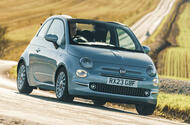
Fiat’s 500 is reliable, ubiquitous and available from less than £1000
Back in the mid-2000s, Fiat was on the brink of extinction as a result of dwindling sales and a model line-up that lacked any real appeal. Fiat’s boss at the time, Luca de Meo, played a masterstroke: he called on design legend Frank Stephenson, who was behind BMW’s similarly conceived Mini revival, to pen a new 500.The result? Fiat’s salvation. The 500 turned the tide for the ailing marque, which sold more than three million examples of the car between 2008 and 2025. No wonder de Meo’s went down the retro route again, when he was CEO of the Renault Group.The cheeky 500 was unique for not only its looks but also the endless customisation Fiat offered. Trawl through the classifieds and you will find examples finished in baby blue, mustard yellow and lipstick red. When it was new, Fiat said it could be specified in more than 549,000 different combinations, with liveries and decals available on top as options.Pop was the entry-level trim and came with central locking, electric windows and door mirrors, as well as MP3 connectivity. Mid-spec Pop Star added air-con but we think top-spec Lounge makes the best used buy, thanks to its alloy wheels, glass sunroof and split rear seats.It was a shame that the 500 didn’t really have the go to back up its show. The 99bhp 1.4-litre petrol (sourced from the Fiat Panda 100hp) was a little sedate and could manage only a 10.3sec sprint to 62mph. It seemed pretty content at motorway speeds, but you did have to work the engine quite hard, with peak power coming in at 6000rpm. We would have liked a little more urgency when pulling into fast-moving traffic.While you could have an automatic gearbox, the clunky SMG automated manual Fiat offered was poor, but the manual is plenty slick enough.If you are buying an older model, the 68bhp 1.2-litre petrol will appeal for its £35 annual road tax, as will the 68mpg promised by the 1.3-litre diesel Multijet.But the unusual two-cylinder Twinair brings the most character – and free road tax. It brought aural rewards too, with the thrummy engine making it more enjoyable to rev out to its 6000rpm redline. Fun to drive it may be, but we were a little disappointed by its real-world economy of around 40mpg – some way off the 68mpg promised by Fiat. More pleasing is the 55mpg you can eke out of the mild-hybrid 1.0-litre powertrain in the real world, though you will pay more for the privilege, given it wasn’t launched until 2020.The early 500 couldn’t quite match the Mini on the ride and handling front, but revisions to its suspension as part of a facelift in 2015 improved things. Alongside the tweaks to its underpinnings, the 500 gained new bumpers, headlights, taillights and a restyled front grille, which make it worth paying a little extra for a slightly newer used example – plus you get the later Uconnect infotainment screen and soft-touch cabin trim.The Twinair gained a boost in power to 104bhp and the 1.2-litre four-cylinder was tweaked to dip below 100g/km CO2 and comply with Euro 6 regulations.Nearly two decades is a long shelf life for a car, but the 500 hasn’t changed all that much during its time in production. You could even go so far as to say it’s approaching the same desirability and iconic status as the 1950s original, though you’ll be glad for the slightly more modern accoutrements on those rainy winter commutes.
Source: Autocar